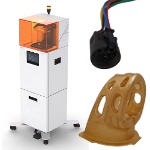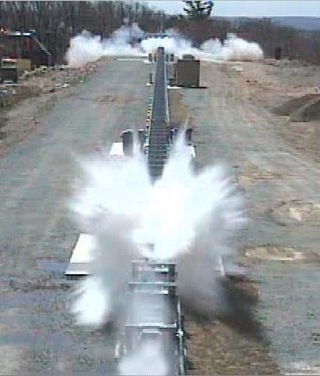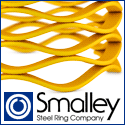 |
| July 11, 2017 | Volume 13 Issue 26 |
Mechanical News & Products
Designfax weekly eMagazine
Archives
Partners
Manufacturing Center
Product Spotlight
Modern Applications News
Metalworking Ideas For
Today's Job Shops
Tooling and Production
Strategies for large
metalworking plants
What's a SLIC Pin®? Pin and cotter all in one!
 The SLIC Pin (Self-Locking Implanted Cotter Pin) from Pivot Point is a pin and cotter all in one. This one-piece locking clevis pin is cost saving, fast, and secure. It functions as a quick locking pin wherever you need a fast-lock function. It features a spring-loaded plunger that functions as an easy insertion ramp. This revolutionary fastening pin is very popular and used successfully in a wide range of applications.
The SLIC Pin (Self-Locking Implanted Cotter Pin) from Pivot Point is a pin and cotter all in one. This one-piece locking clevis pin is cost saving, fast, and secure. It functions as a quick locking pin wherever you need a fast-lock function. It features a spring-loaded plunger that functions as an easy insertion ramp. This revolutionary fastening pin is very popular and used successfully in a wide range of applications.
Learn more.
Engineering challenge: Which 3D-printed parts will fade?
 How does prolonged exposure to intense UV light impact 3D-printed plastics? Will they fade? This is what Xometry's Director of Application Engineering, Greg Paulsen, set to find out. In this video, Paulsen performs comprehensive tests on samples manufactured using various additive processes, including FDM, SLS, SLA, PolyJet, DLS, and LSPc, to determine their UV resistance. Very informative. Some results may surprise you.
How does prolonged exposure to intense UV light impact 3D-printed plastics? Will they fade? This is what Xometry's Director of Application Engineering, Greg Paulsen, set to find out. In this video, Paulsen performs comprehensive tests on samples manufactured using various additive processes, including FDM, SLS, SLA, PolyJet, DLS, and LSPc, to determine their UV resistance. Very informative. Some results may surprise you.
View the video.
Copper filament for 3D printing
 Virtual Foundry, the company that brought us 3D-printable lunar regolith simulant, says its popular Copper Filamet™ (not a typo) is "back in stock and ready for your next project." This material is compatible with any open-architecture FDM/FFF 3D printer. After sintering, final parts are 100% pure copper. Also available as pellets. The company says this is one of the easiest materials to print and sinter. New Porcelain Filamet™ available too.
Virtual Foundry, the company that brought us 3D-printable lunar regolith simulant, says its popular Copper Filamet™ (not a typo) is "back in stock and ready for your next project." This material is compatible with any open-architecture FDM/FFF 3D printer. After sintering, final parts are 100% pure copper. Also available as pellets. The company says this is one of the easiest materials to print and sinter. New Porcelain Filamet™ available too.
Learn more and get all the specs.
Copper foam -- so many advantages
 Copper foam from Goodfellow combines the outstanding thermal conductivity of copper with the structural benefits of a metal foam. These features are of particular interest to design engineers working in the fields of medical products and devices, defense systems and manned flight, power generation, and the manufacture of semiconductor devices. This product has a true skeletal structure with no voids, inclusions, or entrapments. A perennial favorite of Designfax readers.
Copper foam from Goodfellow combines the outstanding thermal conductivity of copper with the structural benefits of a metal foam. These features are of particular interest to design engineers working in the fields of medical products and devices, defense systems and manned flight, power generation, and the manufacture of semiconductor devices. This product has a true skeletal structure with no voids, inclusions, or entrapments. A perennial favorite of Designfax readers.
Learn more.
Full-color 3D-printing Design Guide from Xometry
 With Xometry's PolyJet 3D-printing service, you can order full-color 3D prints easily. Their no-cost design guide will help you learn about different aspects of 3D printing colorful parts, how to create and add color to your models, and best practices to keep in mind when printing in full color. Learn how to take full advantage of the 600,000 unique colors available in this flexible additive process.
With Xometry's PolyJet 3D-printing service, you can order full-color 3D prints easily. Their no-cost design guide will help you learn about different aspects of 3D printing colorful parts, how to create and add color to your models, and best practices to keep in mind when printing in full color. Learn how to take full advantage of the 600,000 unique colors available in this flexible additive process.
Get the Xometry guide.
Tech Tip: How to create high-quality STL files for 3D prints
 Have you ever 3D printed a part that had flat spots or faceted surfaces where smooth curves were supposed to be? You are not alone, and it's not your 3D printer's fault. According to Markforged, the culprit is likely a lack of resolution in the STL file used to create the part.
Have you ever 3D printed a part that had flat spots or faceted surfaces where smooth curves were supposed to be? You are not alone, and it's not your 3D printer's fault. According to Markforged, the culprit is likely a lack of resolution in the STL file used to create the part.
Read this detailed and informative Markforged blog.
Test your knowledge: High-temp adhesives
 Put your knowledge to the test by trying to answer these key questions on how to choose the right high-temperature-resistant adhesive. The technical experts from Master Bond cover critical information necessary for the selection process, including questions on glass transition temperature and service temperature range. Some of the answers may surprise even the savviest of engineers.
Put your knowledge to the test by trying to answer these key questions on how to choose the right high-temperature-resistant adhesive. The technical experts from Master Bond cover critical information necessary for the selection process, including questions on glass transition temperature and service temperature range. Some of the answers may surprise even the savviest of engineers.
Take the quiz.
Engineer's Toolbox: How to pin a shaft and hub assembly properly
 One of the primary benefits of using a coiled spring pin to affix a hub or gear to a shaft is the coiled pin's ability to prevent hole damage. Another is the coiled pin absorbs wider hole tolerances than any other press-fit pin. This translates to lower total manufacturing costs of the assembly. However, there are a few design guidelines that must be adhered to in order to achieve the maximum strength of the pinned system and prevent damage to the assembly.
One of the primary benefits of using a coiled spring pin to affix a hub or gear to a shaft is the coiled pin's ability to prevent hole damage. Another is the coiled pin absorbs wider hole tolerances than any other press-fit pin. This translates to lower total manufacturing costs of the assembly. However, there are a few design guidelines that must be adhered to in order to achieve the maximum strength of the pinned system and prevent damage to the assembly.
Read this very informative SPIROL article.
What's new in Creo Parametric 11.0?
 Creo Parametric 11.0 is packed with productivity-enhancing updates, and sometimes the smallest changes make the biggest impact in your daily workflows. Mark Potrzebowski, Technical Training Engineer, Rand 3D, runs through the newest functionality -- from improved surface modeling tools to smarter file management and model tree navigation. Videos provide extra instruction.
Creo Parametric 11.0 is packed with productivity-enhancing updates, and sometimes the smallest changes make the biggest impact in your daily workflows. Mark Potrzebowski, Technical Training Engineer, Rand 3D, runs through the newest functionality -- from improved surface modeling tools to smarter file management and model tree navigation. Videos provide extra instruction.
Read the full article.
What's so special about wave springs?
 Don't settle for ordinary springs. Opt for Rotor Clip wave springs. A wave spring is a type of flat wire compression spring characterized by its unique waveform-like structure. Unlike traditional coil springs, wave springs offer an innovative solution to complex engineering challenges, producing forces from bending, not torsion. Their standout feature lies in their ability to compress and expand efficiently while occupying up to 50% less axial space than traditional compression springs. Experience the difference Rotor Clip wave springs can make in your applications today!
Don't settle for ordinary springs. Opt for Rotor Clip wave springs. A wave spring is a type of flat wire compression spring characterized by its unique waveform-like structure. Unlike traditional coil springs, wave springs offer an innovative solution to complex engineering challenges, producing forces from bending, not torsion. Their standout feature lies in their ability to compress and expand efficiently while occupying up to 50% less axial space than traditional compression springs. Experience the difference Rotor Clip wave springs can make in your applications today!
View the video.
New Standard Parts Handbook from JW Winco
 JW Winco's printed Standard Parts Handbook is a comprehensive 2,184-page reference that supports designers and engineers with the largest selection of standard parts categorized into three main groups: operating, clamping, and machine parts. More than 75,000 standard parts can be found in this valuable resource, including toggle clamps, shaft collars, concealed multiple-joint hinges, and hygienically designed components.
JW Winco's printed Standard Parts Handbook is a comprehensive 2,184-page reference that supports designers and engineers with the largest selection of standard parts categorized into three main groups: operating, clamping, and machine parts. More than 75,000 standard parts can be found in this valuable resource, including toggle clamps, shaft collars, concealed multiple-joint hinges, and hygienically designed components.
Get your Standard Parts Handbook today.
Looking to save space in your designs?
 Watch Smalley's quick explainer video to see how engineer Frank improved his product designs by switching from traditional coil springs to compact, efficient wave springs. Tasked with making his products smaller while keeping costs down, Frank found wave springs were the perfect solution.
Watch Smalley's quick explainer video to see how engineer Frank improved his product designs by switching from traditional coil springs to compact, efficient wave springs. Tasked with making his products smaller while keeping costs down, Frank found wave springs were the perfect solution.
View the video.
Top die casting design tips
 You can improve the design and cost of your die cast parts with these top tips from Xometry's Joel Schadegg. Topics include: Fillets and Radii, Wall Thicknesses, Ribs and Metal Savers, Holes and Windows, Parting Lines, and more. Follow these recommendations so you have the highest chance of success with your project.
You can improve the design and cost of your die cast parts with these top tips from Xometry's Joel Schadegg. Topics include: Fillets and Radii, Wall Thicknesses, Ribs and Metal Savers, Holes and Windows, Parting Lines, and more. Follow these recommendations so you have the highest chance of success with your project.
Read the full Xometry article.
What's the latest from 3D Systems? Innovations for different industries, processes
 3D Systems unveiled several new solutions at the RAPID+TCT 2025 show in April designed to change the way industries innovate. From new 3D printers and materials for high-mix, low-volume applications to marked improvements in how investment casting can be done, learn what is the state of the art from the original inventors of 3D printing.
3D Systems unveiled several new solutions at the RAPID+TCT 2025 show in April designed to change the way industries innovate. From new 3D printers and materials for high-mix, low-volume applications to marked improvements in how investment casting can be done, learn what is the state of the art from the original inventors of 3D printing.
Read the full article.
Clever! Indexing plungers with chamfered pins
 JW Winco has developed a new type of indexing plunger -- GN 824 -- that can independently latch into edges and grooves. This is made possible by a chamfered plunger pin. When the chamfered pin encounters a raised latching geometry, it retracts and then springs back out again once it reaches the latching point. This new indexing plunger can be ordered with axial thread for fastening and a black plastic knob for operating the indexing plunger. In a clever design, the plunger pin can be adjusted by 360 degrees to ensure that it encounters the mating surface perpendicularly. This hardware is well suited for transport frames, mechanisms, or covers that need to be locked in place quickly and securely, especially without the need for manual intervention.
JW Winco has developed a new type of indexing plunger -- GN 824 -- that can independently latch into edges and grooves. This is made possible by a chamfered plunger pin. When the chamfered pin encounters a raised latching geometry, it retracts and then springs back out again once it reaches the latching point. This new indexing plunger can be ordered with axial thread for fastening and a black plastic knob for operating the indexing plunger. In a clever design, the plunger pin can be adjusted by 360 degrees to ensure that it encounters the mating surface perpendicularly. This hardware is well suited for transport frames, mechanisms, or covers that need to be locked in place quickly and securely, especially without the need for manual intervention.
Learn more.
One-of-a-kind 'cannon tube' SCat gun used to improve munition design fires 1,000th shot

The U.S. Army's 155-mm Soft Catch Gun (SCat gun) in action.
Engineers with the U.S. Army Armament Research, Development and Engineering Center (ARDEC) at Picatinny Arsenal in New Jersey set a milestone when they fired the 1,000th shot from the 155-mm Soft Catch Gun (aka the SCat gun) last year.
The system is comprised of a 155-mm Howitzer with a M199 gun tube and 540 ft of catch tubes.
Engineers are able to measure the forces a 155-mm projectile experiences after being fired from a cannon tube. The data is recorded using on-board recorders, which help engineers design robust and reliable precision munition systems and components.
That information is then transferred to a computer and analyzed. The data provides valuable feedback to engineers and warfighters to help in the future development of weapons and munitions systems.
According to records, the first shot from the SCat gun was fired April 30, 2007 at 12:15 p.m. Roughly nine years later, on June 21, 2016 at 9:43 a.m., the 1,000th shot was fired.
"The team has reached a pinnacle for testing of developmental items for future Armament systems for Precision Guided Weapon and Munition systems," said Robert Marchak, mechanical engineer in the Fuze Division of the Munitions Engineering Technology Center.
"The future is an open door at this point and will help ARDEC to achieve more capabilities for the warfighter. With the future brings new opportunities for advancement in more systems to assist in development for the DoD," he said.
"The SCat Gun was designed to last for 50 years. With proper maintenance and upkeep, it will last even longer. Efforts are underway to assess the current system and future development for other assets to fill the gap for testing of High-G and Higher Velocity Armament Systems being developed by the Tri Services and DoD contractors and other government agencies," Marchak added.
How the SCat gun works
SCat is a hybrid system that uses both pressurized air and water to help slow down the projectile's momentum. It is the only system of its kind in the world.
The first part of the chain of catch tubes only contains atmospheric air. The next section, 320 ft of the tubes, contains pressurized air, followed by an 80-ft section with water.
A small burst diaphragm seals one end of the pressurized air and a piston seals the other end.
The piston also separates the water and pressurized air sections. The burst diaphragm and piston are replaced after each test fire.
VIDEO: Engineers with the U.S. Army Armament Research, Development and Engineering Center set a milestone last year when they fired the 1,000th shot from the 155-mm Soft Catch Gun (also known as the SCat gun).
Once fired, the projectile achieves free flight for approximately 6 ft and travels down the catch tubes, generating shockwaves that interact with the atmospheric air section, the burst diaphragm, the pressurized air section, the piston, and the water section.
In a little over 1 sec, the projectile shock waves break the burst diaphragm. The air section is compressed and pushed forward, and shock and pressure shear the piston, moving it against the water (momentum transfer), all while slowing the projectile to a stop.
The piston is ejected out of the end of the system, followed by the air and water, and finally the projectile comes to rest in a mechanized brake system.
On-board recorders inside the projectile measure the accelerations of the projectile from the gun-launch and the catch events.
With a muzzle velocity of 888 m/sec, the entire test takes a little over 1 sec from the time the projectile is fired until it has completely stopped.
The speed of 888 m/sec is equal to 1,986 mph.
Source: Picatinny Arsenal
Published March 2017
Rate this article
View our terms of use and privacy policy

